Book contents
- The Cambridge Handbook of Germanic Linguistics
- Cambridge Handbooks in Language and Linguistics
- The Cambridge Handbook of Germanic Linguistics
- Copyright page
- Contents
- Figures
- Maps
- Tables
- Contributors
- Acknowledgments
- Germanic Languages
- Part I Phonology
- Part II Morphology and Agreement Systems
- Part III Syntax
- Chapter 15 VO-/OV-Base Ordering
- Chapter 16 The Placement of Finite Verbs
- Chapter 17 Germanic Infinitives
- Chapter 18 The Unification of Object Shift and Object Scrambling
- Chapter 19 Unbounded Dependency Constructions in Germanic
- Chapter 20 The Voice Domain in Germanic
- Chapter 21 Binding
- Chapter 22 Verbal Particles, Results, and Directed Motion
- Chapter 23 Structure of Noun (NP) and Determiner Phrases (DP)
- Part IV Semantics and Pragmatics
- Part V Language Contact and Nonstandard Varieties
- Index
- References
Chapter 23 - Structure of Noun (NP) and Determiner Phrases (DP)
from Part III - Syntax
Published online by Cambridge University Press: 31 March 2020
- The Cambridge Handbook of Germanic Linguistics
- Cambridge Handbooks in Language and Linguistics
- The Cambridge Handbook of Germanic Linguistics
- Copyright page
- Contents
- Figures
- Maps
- Tables
- Contributors
- Acknowledgments
- Germanic Languages
- Part I Phonology
- Part II Morphology and Agreement Systems
- Part III Syntax
- Chapter 15 VO-/OV-Base Ordering
- Chapter 16 The Placement of Finite Verbs
- Chapter 17 Germanic Infinitives
- Chapter 18 The Unification of Object Shift and Object Scrambling
- Chapter 19 Unbounded Dependency Constructions in Germanic
- Chapter 20 The Voice Domain in Germanic
- Chapter 21 Binding
- Chapter 22 Verbal Particles, Results, and Directed Motion
- Chapter 23 Structure of Noun (NP) and Determiner Phrases (DP)
- Part IV Semantics and Pragmatics
- Part V Language Contact and Nonstandard Varieties
- Index
- References
Summary
Following Abney’s (1987) seminal dissertation, many more phenomena in the noun phrase have been discovered and discussed. In this brief survey, I point out some recent results, some debated topics, and some new avenues for future research. I focus on structural aspects of the noun phrase discussing different nominal elements and how they relate to one another. I use contemporary German as a representative language. This is a highly inflected language, a fact that is often taken to provide clues about the analysis of certain linguistic phenomena. Other Germanic languages are discussed if they show an important relevant difference from German. I also point out some differences between North and West Germanic (East Germanic, e.g., Gothic, no longer exits).
Keywords
- Type
- Chapter
- Information
- The Cambridge Handbook of Germanic Linguistics , pp. 537 - 564Publisher: Cambridge University PressPrint publication year: 2020



